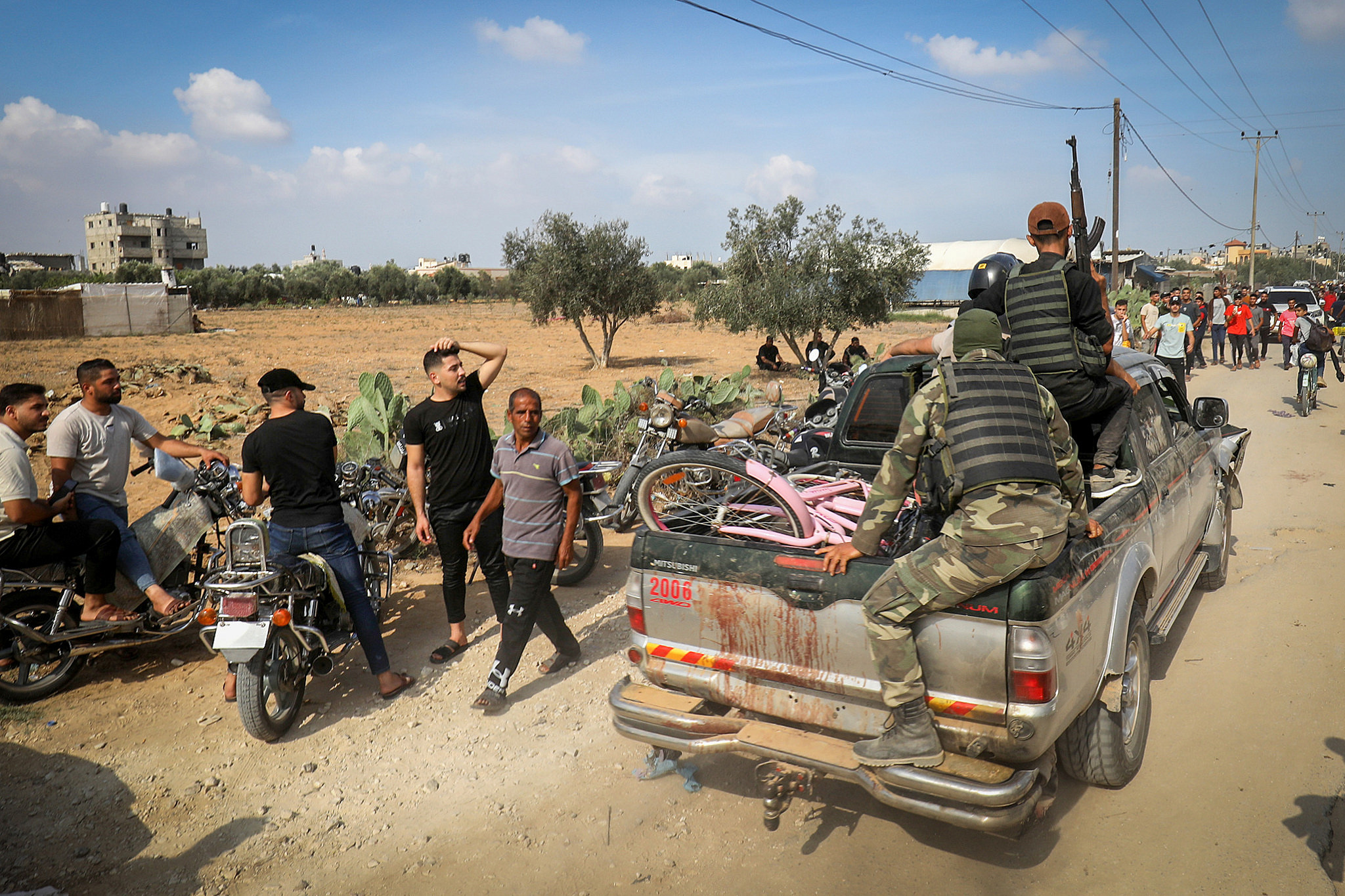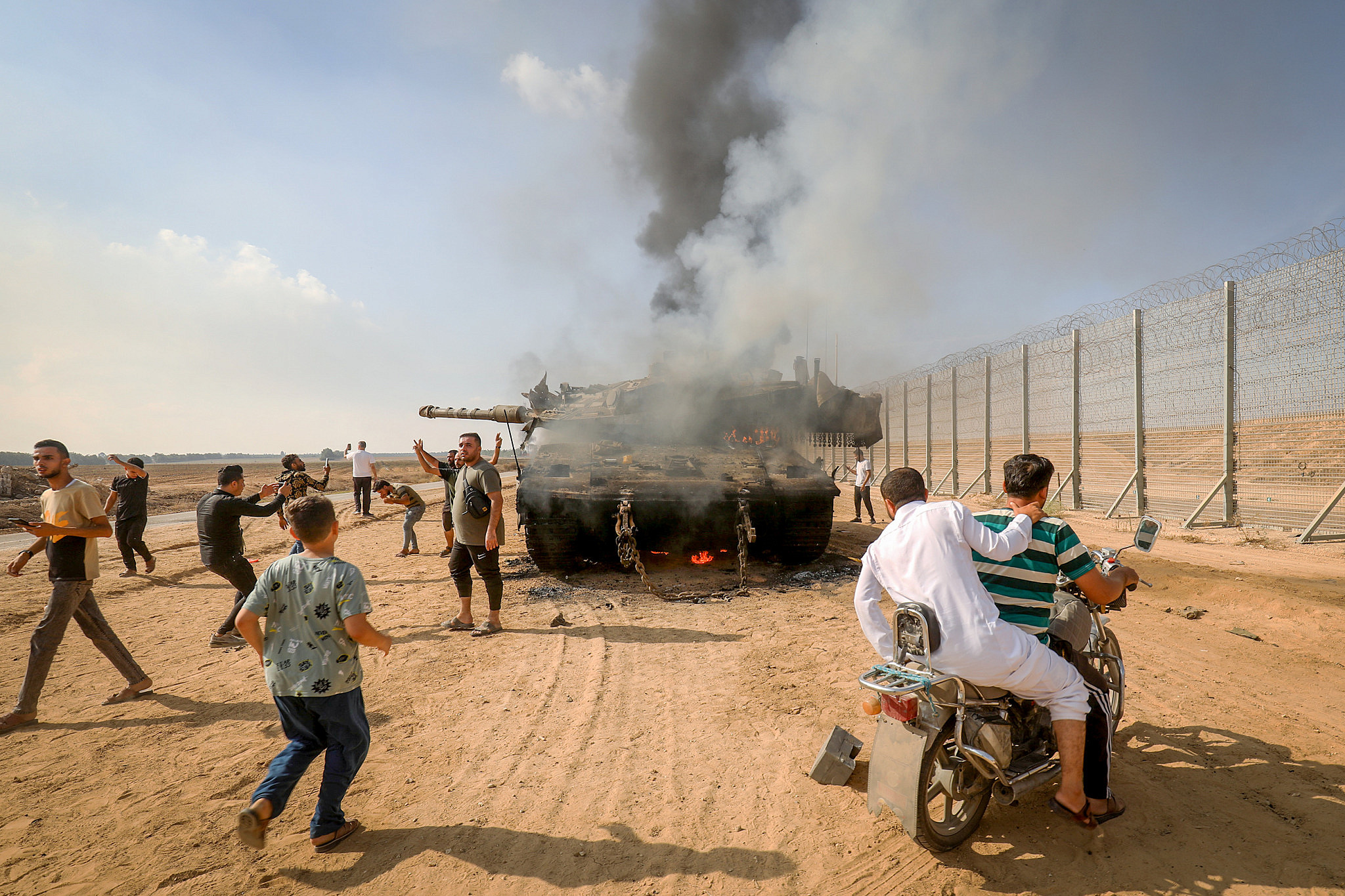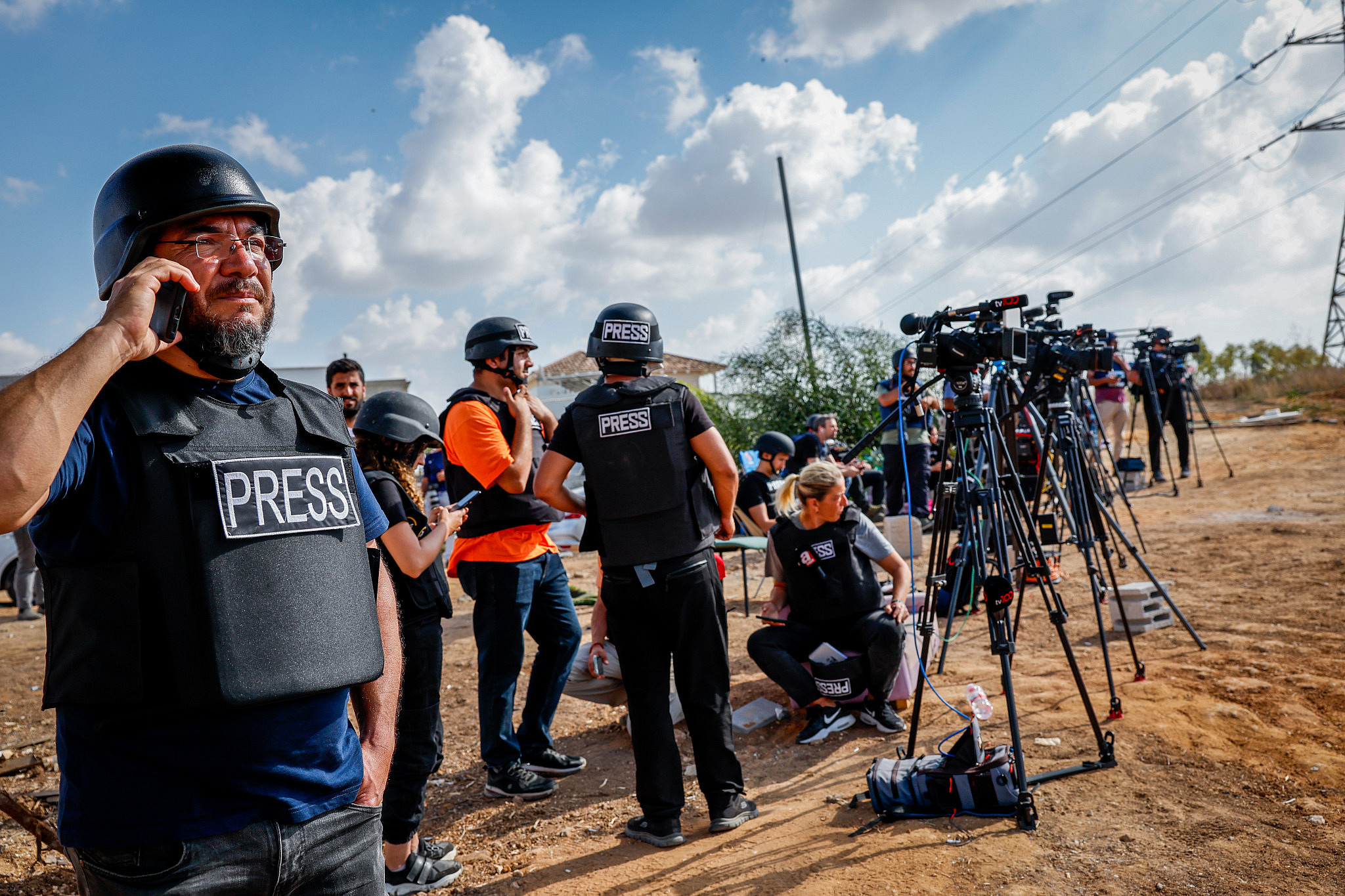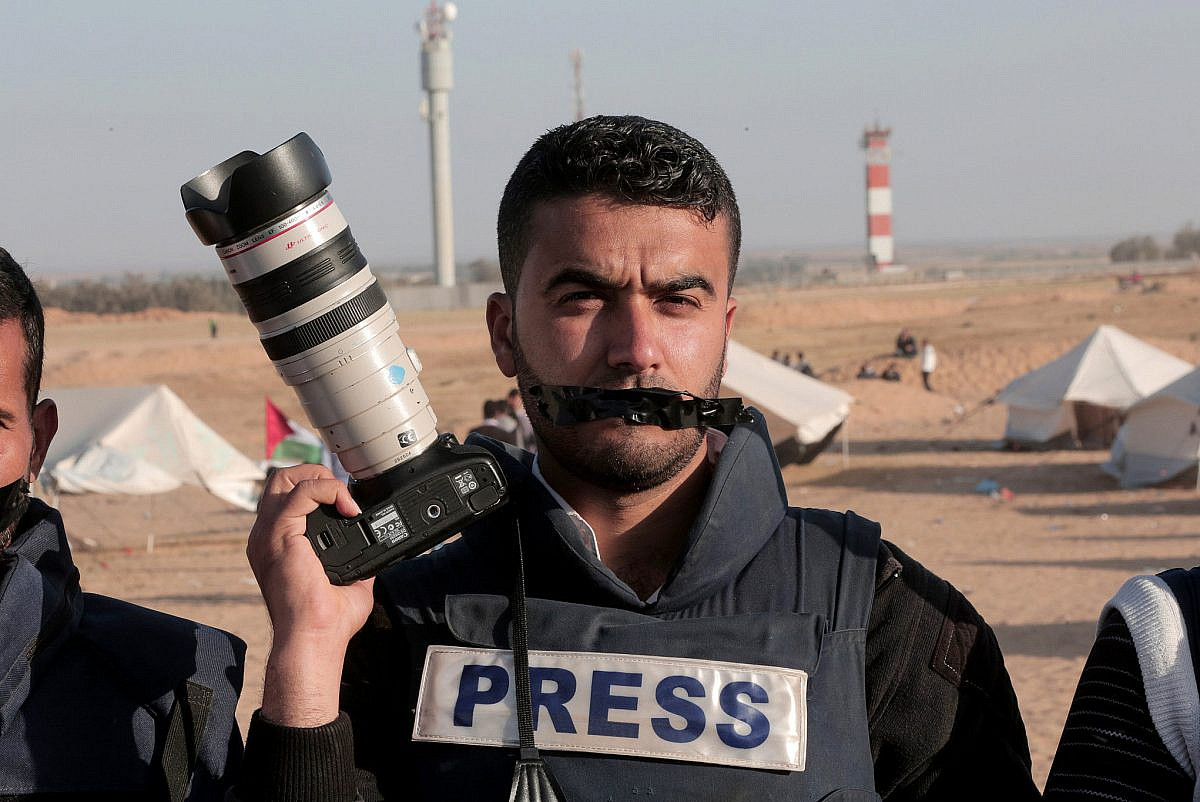On Nov. 8, Honest Reporting, an organization that claims to monitor “anti-Israel” bias in the media, published an “investigation” accusing Palestinian photojournalists in the Gaza Strip of having advance knowledge about Hamas’ lethal October 7 attack on southern Israel. “What were they doing there so early on what would ordinarily have been a quiet Saturday morning?” the report asked of the journalists, whose photographs of Palestinians breaching the fence encaging the Strip have appeared in some of the world’s most prominent news publications in recent weeks. “Was it coordinated with Hamas?”
The report quickly gained traction, with Israel’s Foreign Ministry and the Government Press Office both sharing the report on their official X pages (the former has since deleted the post). Israeli leaders rushed to put out their own condemnations of the journalists, equating them with those responsible for the massacres.
“These journalists were accomplices in crimes against humanity; their actions were contrary to professional ethics,” said a post from the X account of Prime Minister Benjamin Netanyahu’s office. Another, from Benny Gantz — currently a minister without portfolio in Israel’s war cabinet — asserted: “Journalists found to have known about the massacre, and still chose to stand as idle bystanders while children were slaughtered — are no different than terrorists and should be treated as such.”
However, even a cursory examination of the investigation’s claims revealed major discrepancies. While it asserted, for example, that the journalists “happened to be at the border just in time for Hamas’ infiltration,” the photographers’ documentation itself shows that they were not near the Gaza fence when it was first breached at 6:30 a.m. In fact, they arrived there two hours later, when residents of Gaza were already streaming into Israel and Israeli hostages were already being taken back to the Strip by Hamas and other fighters.
Indeed, the allegations against the Palestinian journalists appear to be completely baseless. Gil Hoffman, Honest Reporting’s director and a former longtime correspondent at the Jerusalem Post, admitted as much two days after the report’s publication, in response to refutations issued by the four outlets implicated by the claims: Associated Press, Reuters, CNN, and The New York Times.

“We raised questions, we didn’t give answers,” Hoffman told Reuters, adding that the four outlets’ responses were “adequate.” Hoffman later wrote on X that his “words were twisted and misconstrued” and that “In no way did I backtrack from questions that my team raised.” But the scrutiny of the organization’s claims still stands.
Claims debunked
In order to properly respond to the dangerous claims made by Honest Reporting, it is necessary to understand how both photo agencies and international media outlets work with photographers. First, these organizations usually use staff photographers, independent photographers, and/or photographers who either approach agencies and outlets to sell their photos or are contacted by these bodies to buy their work.
On October 7, there were no international photographers in Gaza (who would require permits from the Israeli authorities to enter the Strip), and since Hamas’ attack and the start of Israel’s intensified siege and bombardment, none have been able to enter. Therefore, for the purpose of covering the events of that day, the media relied on their permanent local Palestinian staff as well as additional Palestinian photographers.
The Israeli media, which parroted Honest Reporting’s allegations unquestioningly, claimed that the Palestinian photographers “documented the massacre.” This is false: while one journalist photographed a mob attacking the body of a dead soldier that had been removed from an Israeli tank along the Gaza fence, none of them documented killing. The photographs mentioned in the report went online in real time, with full credit to the photographers, and Israeli media outlets themselves used these photos extensively. Some of them have become iconic, such as the image of a commandeered tank that was set on fire next to the Gaza fence.
Nonetheless, the international outlets mentioned in the report took Honest Reporting’s claims seriously, and conducted their own investigations. CNN, The New York Times, AP, and Reuters all looked into the allegations and offered responses. AP, for example, emphasized that it did not know in advance about the attack, and that the initial photographs — taken by freelancers — were taken more than an hour after the attack began. The other outlets published similar clarifying statements.

Hassan Eslaiah, who sold photographs of Palestinians entering Kibbutz Nir Oz to AP, had worked with the agency in the past. Biranit Goren, the editor-in-chief of Zman Yisrael, analyzed both Eslaiah’s activity on social media as well as the photographs he took on the morning of October 7, and concluded that he was not present at the beginning of the attack.
Only at 8:27 a.m., about two hours after the attack began, did Eslaiah start a live broadcast on Facebook showing himself running toward the breach in the fence, along with dozens of other Palestinians. He later recorded himself riding a motorcycle with several people, one of whom was holding a grenade.
Even after Honest Reporting admitted they had no proof that the photographers were complicit in the attack, most of the Israeli media that reported on the initial findings did not bother to publish anything about the organization’s sudden change in tune. The claim that Palestinian journalists were responsible for Hamas’ war crimes has already taken root and become just one more example in the wave of attacks by the Israeli public against Palestinian journalists.
A flawed logic
Like photojournalists all over the world, the Gaza-based photographers arrived to fulfill their journalistic duty and document a difficult, painful, and cruel event, of which they did not know all the details at the time. Apart from one photographer who sold his photographs from inside Gaza City to the AP, the rest of the photographers remained near the fence.
Had the photographers indeed known about the attack in advance, one would have seen their footage of Hamas breaching the Gaza fence in the early hours of the morning, and the entry of Hamas militants into Israeli army bases, kibbutzim, and towns. But in their photographs, one can see Palestinians looting Israeli homes, or kidnapped Israelis being dragged into Gaza — events that took place after the attack began.

The expectation, echoed in Israel and across the world, that a photographer must put their camera down when they see a mob kidnapping civilians or burning tanks, is both practically and politically unfounded. The photographing of atrocities, especially in war, is a complex issue that for decades has been accompanied by ethical discussions on the clash between the professional duty to document and the human duty to try and help those in need.
The Palestinian photographers set out to document an event that took place near their homes. That same morning, Israeli photojournalists — myself included — set out to document the events in the south. We filmed the wounded, the bodies lying on the ground, and the gun battles at the Sderot police station between Palestinian fighters and Israeli security forces. Does this mean we had a hand in the events or could have helped? Of course not.
If the logic that photographers are responsible for what they see and document were true, we would never have seen Eddie Adams’ famous image of South Vietnamese soldiers executing a member of the Viet Cong. We would not have been exposed to war crimes committed by Serbian soldiers that were documented by Ron Haviv in Bosnia, or to Chris Hondros’ haunting photo of an Iraqi girl whose parents were shot dead by American soldiers. No one blamed these photographers for the crimes they documented, even though some of them accompanied the forces responsible.
Most read on +972
It is difficult to accept that an unfounded investigation was accepted by large parts of the Israeli media as fact, went viral on social media, was quoted without reservation, and strengthened the incitement against those who are trying in impossible conditions to document the reality on the ground. Israel has killed at least 39 journalists in Gaza since the war began. The accusations made by Honest Reporting serve to legitimize their deaths and the bloodletting of others.
Had the organization bothered to contact the various media outlets for a response before publishing their claims, the damage could have been avoided. But as Hoffman told AP, Honest Reporting doesn’t “claim to be a news organization,” and thus, it seems, the traditional journalistic standards of asking for comment before publication does not apply to them. Honest Reporting is a right-wing, hasbara organization with a clear agenda, and should be treated as such by all who interact with it.
A version of this article was first published in Hebrew on Local Call. Read it here.






